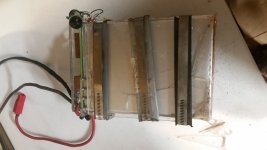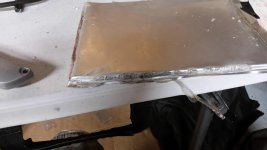themadhatter106
100 W
Ok so maybe it's not the biggest fail ever but please take this opportunity to point and laugh and also maybe give advice (if you feel so inclined).
Many cells on only one half of my battery pack got damaged (holes in the foil on the bottom) and leaked electrolyte as well. The acrylic that I was using to compress the cells cracked too but didn't puncture the cell as far as I can tell. I discovered this when I had not used my bike for months and wanted to use it, the BMS was cutting out. One cell on the end was at 0V but all of the other cell voltages were fine even the ones that turned out to have nicks in the foil.
When I took the pack off my bike it was making a hissing sound. "Well that can't be good!" It didn't catch on fire or even get hot; I'm thanking LiFePO4 for its ability to resist such catastrophes.
This is a split 20S A123 pack I made mounted with each half on either side of my front fork. I compressed the cells using acrylic, steel flat bar and hose clamps. The two half packs were covered in padding and held in a custom mount. Everything was fine for about a year until I had to change my mount because I was changing to a new fork. There are two differences past this point, the new mount has the battery not perpendicular to the ground but at an angle instead, the rake angle of the fork. Also, On one half I noticed that the Styrofoam insulation I used as padding was starting to degrade and I didn't have enough to cut more for both half packs so Instead I used soft mail packaging foam of the same thickness.
It's odd that one half was undamaged and the other half was completely frocked up! I think the Styrofoam must be better at protecting the battery than the soft foam padding. Although, the soft foam was still intact with no holes. Also I think having the pack at an angle to the ground may have put more stress on one side of the pack or caused the pack to rub more over bumps.
Once I replace the botched cells I want to solve this problem.
I am thinking of still using hose clamps but using a different material which won't crack. I want to use 1/4" aluminum since it will provide the most even distribution of force without needing really big and thick plastic plates. The only problem is that it's conductive so I will want some type of insulation for safety. Maybe a sheet of rubber so that when the pack swells with each charge cycle the rubber can squash down a little to accommodate the thicker cells? I could make the aluminum extend a bit below the bottom of the cells to prevent them from getting damaged there.
I also don't have any insulating material between the cells. I should probably add some since I see some spots towards the middle in between some of the cells in the pack which are disconcerting. Any suggestions?
Many cells on only one half of my battery pack got damaged (holes in the foil on the bottom) and leaked electrolyte as well. The acrylic that I was using to compress the cells cracked too but didn't puncture the cell as far as I can tell. I discovered this when I had not used my bike for months and wanted to use it, the BMS was cutting out. One cell on the end was at 0V but all of the other cell voltages were fine even the ones that turned out to have nicks in the foil.
When I took the pack off my bike it was making a hissing sound. "Well that can't be good!" It didn't catch on fire or even get hot; I'm thanking LiFePO4 for its ability to resist such catastrophes.
This is a split 20S A123 pack I made mounted with each half on either side of my front fork. I compressed the cells using acrylic, steel flat bar and hose clamps. The two half packs were covered in padding and held in a custom mount. Everything was fine for about a year until I had to change my mount because I was changing to a new fork. There are two differences past this point, the new mount has the battery not perpendicular to the ground but at an angle instead, the rake angle of the fork. Also, On one half I noticed that the Styrofoam insulation I used as padding was starting to degrade and I didn't have enough to cut more for both half packs so Instead I used soft mail packaging foam of the same thickness.
It's odd that one half was undamaged and the other half was completely frocked up! I think the Styrofoam must be better at protecting the battery than the soft foam padding. Although, the soft foam was still intact with no holes. Also I think having the pack at an angle to the ground may have put more stress on one side of the pack or caused the pack to rub more over bumps.
Once I replace the botched cells I want to solve this problem.
I am thinking of still using hose clamps but using a different material which won't crack. I want to use 1/4" aluminum since it will provide the most even distribution of force without needing really big and thick plastic plates. The only problem is that it's conductive so I will want some type of insulation for safety. Maybe a sheet of rubber so that when the pack swells with each charge cycle the rubber can squash down a little to accommodate the thicker cells? I could make the aluminum extend a bit below the bottom of the cells to prevent them from getting damaged there.
I also don't have any insulating material between the cells. I should probably add some since I see some spots towards the middle in between some of the cells in the pack which are disconcerting. Any suggestions?



